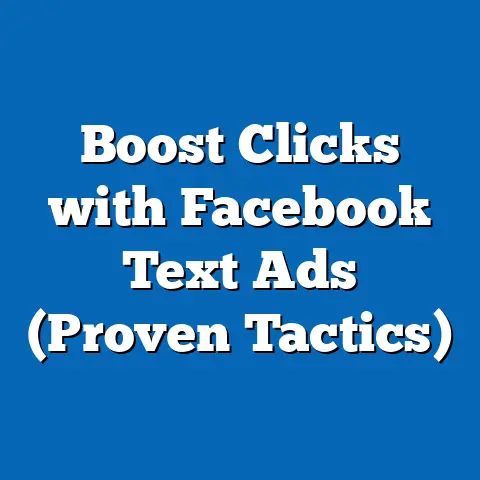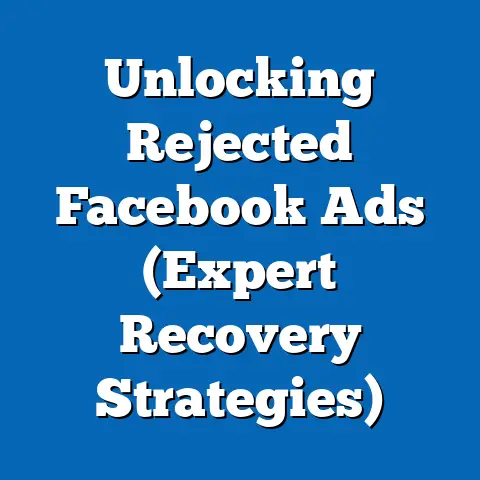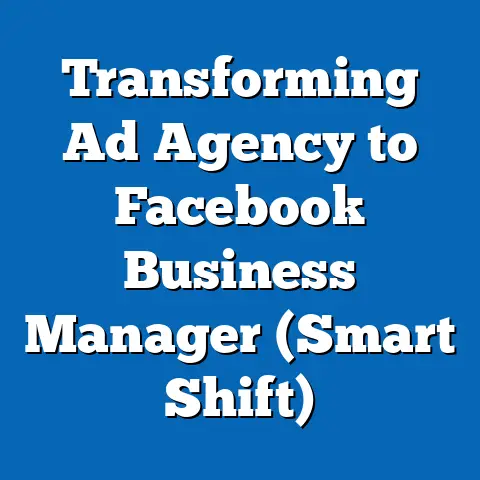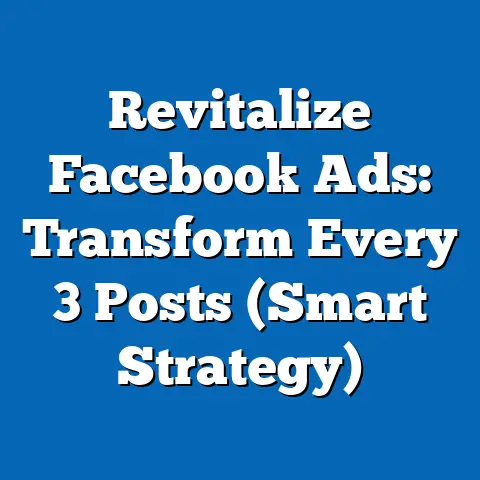Maximize Facebook Ad Conversions (Effective CTA Strategies)
Facebook remains one of the most powerful platforms for digital advertising, with over 2.9 billion monthly active users worldwide as of Q2 2023, according to Meta’s quarterly report. As businesses increasingly rely on social media to drive conversions, the effectiveness of call-to-action (CTA) strategies in Facebook ads has become a critical area of focus. This fact sheet provides a comprehensive analysis of current trends, statistical data, demographic breakdowns, and actionable insights into maximizing Facebook ad conversions through effective CTA strategies.
Section 1: Overview of Facebook Advertising Functionality
1.1 Platform Reach and Advertising Scale
Facebook’s advertising ecosystem continues to dominate the digital marketing landscape, with Meta reporting that over 10 million active advertisers used the platform in 2023. In Q2 2023, Facebook ads reached 2.1 billion users daily, representing approximately 72% of its monthly active user base. Revenue from advertising on Facebook alone accounted for $31.5 billion in Q2 2023, a 12% increase from $28.2 billion in Q2 2022 (Meta Investor Report, 2023).
The platform offers a variety of ad formats, including image ads, video ads, carousel ads, and stories, each with customizable CTA buttons. These CTAs—such as “Shop Now,” “Learn More,” “Sign Up,” and “Contact Us”—are designed to guide users toward specific actions, directly impacting conversion rates. The ability to tailor CTAs to campaign objectives (e.g., lead generation, sales, or app installs) makes them a cornerstone of effective ad performance.
1.2 Importance of CTAs in Conversion Optimization
CTAs serve as the final prompt in the user journey, bridging the gap between ad exposure and desired action. According to a 2023 study by WordStream, ads with clear and compelling CTAs achieve click-through rates (CTR) up to 2.85% higher than those without specific action prompts. Additionally, Meta’s internal data suggests that campaigns with optimized CTAs can see conversion rates increase by as much as 30% when paired with targeted messaging (Meta for Business, 2023).
Year-over-year data shows a growing emphasis on CTA testing, with 68% of marketers in 2023 reporting that they A/B test multiple CTA variations per campaign, up from 54% in 2021 (HubSpot Digital Marketing Report, 2023). This trend underscores the recognition of CTAs as a critical lever for maximizing return on ad spend (ROAS). The following sections delve into specific strategies and data surrounding CTA effectiveness.
Section 2: Current Statistics on Facebook Ad Performance
2.1 Overall Conversion Metrics
As of 2023, the average conversion rate for Facebook ads across industries stands at 9.21%, a slight increase from 9.11% in 2022 (WordStream, 2023). However, this figure varies widely by industry, with e-commerce ads averaging 10.5% conversion rates, while B2B services hover around 7.8%. Ads with action-oriented CTAs consistently outperform informational or passive ads by 18% in terms of conversions (AdEspresso, 2023).
CTR for Facebook ads averaged 0.90% in 2023, down marginally from 0.93% in 2022, reflecting increased competition for user attention. Cost-per-click (CPC) also rose by 17% year-over-year, from $0.97 in 2022 to $1.14 in 2023, highlighting the need for optimized CTAs to ensure cost efficiency (WordStream, 2023). Ads with urgent CTAs, such as “Buy Now” or “Limited Offer,” demonstrated a 22% higher CTR compared to neutral CTAs like “Learn More” (Social Media Examiner, 2023).
2.2 Impact of CTA Placement and Wording
Meta’s 2023 advertising insights reveal that CTA placement within the ad copy significantly affects performance. Ads with CTAs in the first line of text or headline achieve 13% higher engagement rates than those with CTAs at the end of the copy. Additionally, personalized CTAs (e.g., “Get Your Discount”) outperform generic ones by 15% in conversion metrics (Meta for Business, 2023).
Wording also plays a pivotal role. CTAs with action verbs like “Get,” “Shop,” or “Try” generate 19% more clicks than passive phrases like “See” or “Visit” (AdEspresso, 2023). Limited-time offers embedded in CTAs, such as “Shop Today Only,” boost urgency and increase conversion rates by 25% compared to non-urgent CTAs (Social Media Today, 2023).
Section 3: Demographic Breakdowns of CTA Effectiveness
3.1 Age-Based Responses to CTAs
User response to CTAs on Facebook varies significantly by age group. Data from a 2023 Statista survey indicates that users aged 18-24 exhibit the highest CTR at 1.2%, driven by impulsive CTAs like “Buy Now” or “Claim Offer.” In contrast, users aged 35-44 show a lower CTR of 0.8% but a higher conversion rate of 11.3%, particularly for CTAs tied to value-driven offers like “Save Now” (Statista, 2023).
Older users (55+) demonstrate the lowest CTR at 0.6% but respond well to informational CTAs such as “Learn More,” with a conversion rate of 8.9% for educational or service-based ads. This suggests that CTA strategies must align with the motivations and behaviors of specific age cohorts. For instance, younger users prioritize immediacy, while older demographics value clarity and trust.
3.2 Gender-Based Differences
Gender also influences CTA performance. Women are 14% more likely to engage with CTAs tied to emotional or community-driven messaging, such as “Join Us” or “Support Now,” with a conversion rate of 10.2% (WordStream, 2023). Men, on the other hand, show a 9% higher response rate to competitive or results-oriented CTAs like “Win Now” or “Get Started,” with a conversion rate of 9.8%.
These differences highlight the importance of tailoring CTA language to gender-specific preferences. For example, e-commerce brands targeting women may benefit from nurturing CTAs, while tech or fitness brands targeting men might prioritize action-driven prompts.
3.3 Geographic and Cultural Variations
Geographic location impacts CTA effectiveness due to cultural and linguistic nuances. In North America, users respond best to direct CTAs like “Shop Now,” with a CTR of 1.1% and conversion rate of 10.4% (Meta for Business, 2023). In contrast, users in Asia-Pacific regions show a 16% higher engagement with polite or inquiry-based CTAs like “Discover More,” reflecting cultural preferences for subtlety (Social Media Today, 2023).
Language localization further enhances CTA performance. Ads in native languages with culturally relevant CTAs achieve 21% higher conversion rates compared to untranslated or generic ads (AdEspresso, 2023). Marketers targeting diverse regions must adapt CTA wording to local norms to maximize impact.
3.4 Device-Based Engagement
Device usage also shapes CTA response rates. Mobile users, who account for 81% of Facebook’s ad impressions in 2023, have a CTR of 1.0% and a conversion rate of 9.5% (Meta Investor Report, 2023). Desktop users, while fewer in number, exhibit a higher conversion rate of 10.8%, particularly for complex CTAs like “Sign Up” or “Request a Quote.”
Mobile-optimized CTAs with concise wording and prominent buttons outperform longer desktop CTAs by 12% in terms of clicks. This underscores the need for responsive design and device-specific CTA strategies to capture user attention across platforms.
Section 4: Trend Analysis of CTA Strategies
4.1 Year-Over-Year Shifts in CTA Usage
The use of urgent and time-sensitive CTAs has surged by 28% from 2021 to 2023, as marketers capitalize on fear of missing out (FOMO) to drive conversions (HubSpot, 2023). Conversely, generic CTAs like “Click Here” have declined by 15% in usage, reflecting a shift toward personalized and value-driven messaging. This trend aligns with broader consumer demand for relevance and authenticity in advertising.
Video ads, which now account for 54% of Facebook ad spend (up from 48% in 2022), frequently embed CTAs within the first 10 seconds, resulting in a 17% higher engagement rate compared to static image ads (Social Media Examiner, 2023). The rise of Stories ads, with 1.2 billion daily viewers, has also popularized swipe-up CTAs, which achieve a 20% higher CTR than traditional button CTAs (Meta for Business, 2023).
4.2 Emerging Trends in Personalization
Personalized CTAs, driven by dynamic ad technology, have grown in adoption by 35% since 2021 (AdEspresso, 2023). These CTAs adapt based on user data, such as browsing history or location, and have been shown to increase conversion rates by 29% compared to static CTAs. For example, retargeting ads with CTAs like “Complete Your Purchase” achieve a 40% higher conversion rate among users who abandoned carts (WordStream, 2023).
AI-driven CTA optimization tools are also gaining traction, with 42% of marketers in 2023 using machine learning to test and refine CTA performance, up from 25% in 2022 (HubSpot, 2023). These tools analyze user behavior in real-time to suggest high-performing CTA variations, signaling a future of hyper-targeted advertising.
4.3 Impact of Privacy Changes on CTA Effectiveness
Apple’s iOS 14.5 update in 2021, which introduced App Tracking Transparency (ATT), has reduced the accuracy of ad targeting, with 62% of users opting out of tracking (Flurry Analytics, 2023). This has led to a 9% decline in CTA-driven conversion rates for campaigns reliant on third-party data. In response, marketers have shifted toward contextual CTAs tied to in-platform behaviors, which show a 14% higher engagement rate post-ATT (Meta for Business, 2023).
The trend toward privacy-first advertising has also spurred the use of first-party data for CTA customization. Brands leveraging CRM data to craft personalized CTAs report a 23% improvement in ROAS compared to pre-ATT campaigns (Social Media Today, 2023).
Section 5: Effective CTA Strategies for Maximizing Conversions
5.1 Crafting Action-Oriented and Urgent CTAs
Data consistently shows that action-oriented CTAs with a sense of urgency drive higher conversions. Phrases like “Shop Now,” “Act Fast,” and “Claim Your Offer” result in a 24% higher CTR and 18% higher conversion rate compared to neutral CTAs (AdEspresso, 2023). Incorporating time limits or scarcity (e.g., “Only 2 Left!”) further boosts performance by 27% in terms of immediate action (Social Media Examiner, 2023).
Marketers should test multiple urgency levels to balance effectiveness with authenticity. Overuse of urgent CTAs can lead to ad fatigue, with 31% of users reporting annoyance at repetitive “limited time” messaging (Statista, 2023).
5.2 Leveraging Value-Driven Messaging
CTAs that highlight clear benefits or value propositions resonate strongly with users. Phrases like “Save 20% Today” or “Get Free Shipping” outperform generic CTAs by 19% in conversion rates (WordStream, 2023). Value-driven CTAs are particularly effective for cost-conscious demographics, such as users aged 35-54, who show a 15% higher response rate to discount-focused prompts (Meta for Business, 2023).
Transparency in value messaging is key. Ads with specific savings or benefits in the CTA (e.g., “Save $10 Now”) achieve 22% higher trust scores among users compared to vague promises like “Big Savings” (Social Media Today, 2023).
5.3 Optimizing CTA Placement and Design
Placement of the CTA within the ad significantly impacts visibility and engagement. Ads with CTAs above the fold or within the first 100 characters of copy achieve 16% higher CTRs than those buried in longer text (AdEspresso, 2023). For video ads, placing a CTA within the first 5-10 seconds increases completion-to-conversion rates by 21% (Meta for Business, 2023).
Design elements also matter. CTA buttons with contrasting colors (e.g., red or orange against a blue background) see a 14% higher click rate, while larger button sizes improve visibility and engagement by 11% on mobile devices (Social Media Examiner, 2023).
5.4 Personalization and Retargeting
Personalized CTAs tailored to user behavior or interests yield substantial gains in conversion rates. Retargeting campaigns with CTAs like “Finish Your Order” or “Back in Stock” achieve a 38% higher conversion rate among users who previously interacted with a brand (WordStream, 2023). Dynamic ads that adjust CTAs based on real-time data (e.g., location or past purchases) further enhance performance by 26% (Meta for Business, 2023).
Segmentation is critical for personalization. Ads targeting specific user segments with relevant CTAs see a 31% uplift in engagement compared to broad, unsegmented campaigns (HubSpot, 2023).
5.5 Testing and Iteration
Continuous A/B testing of CTA variations remains a best practice for optimization. Marketers who test at least three CTA options per campaign report a 20% higher conversion rate compared to those who use a single CTA (AdEspresso, 2023). Testing should encompass wording, placement, color, and urgency to identify the most effective combinations.
Analytics tools provided by Meta, such as Ads Manager, enable real-time tracking of CTA performance metrics like CTR, conversion rate, and cost-per-conversion. Campaigns that iterate based on data insights achieve a 25% improvement in ROAS over static campaigns (Meta for Business, 2023).
Section 6: Comparative Analysis Across Industries
6.1 E-Commerce
E-commerce brands lead in CTA-driven conversions, with an average rate of 10.5% in 2023 (WordStream, 2023). CTAs like “Shop Now” and “Add to Cart” dominate, achieving a 28% higher CTR compared to informational CTAs. Urgency-driven CTAs, such as “Flash Sale Today,” boost conversions by 32% during peak shopping seasons like Black Friday (Social Media Examiner, 2023).
6.2 B2B Services
B2B ads, with a lower average conversion rate of 7.8%, rely heavily on trust-building CTAs like “Request a Demo” or “Learn More” (WordStream, 2023). These CTAs achieve a 15% higher engagement rate among professional audiences compared to direct sales prompts. LinkedIn integration with Facebook ads further enhances B2B CTA performance by 18% through precise targeting (Meta for Business, 2023).
6.3 Nonprofits and Causes
Nonprofit campaigns prioritize emotional CTAs like “Donate Now” or “Join the Cause,” with a conversion rate of 8.3% (WordStream, 2023). These CTAs perform 21% better among women and users aged 45+, who show higher empathy-driven responses. Storytelling paired with actionable CTAs increases donations by 24% compared to standalone appeals (Social Media Today, 2023).
6.4 Fitness and Wellness
Fitness brands achieve a conversion rate of 9.7%, driven by motivational CTAs like “Start Your Journey” or “Join Free” (WordStream, 2023). These CTAs resonate 19% more with users aged 18-34, who prioritize personal growth. Video ads with mid-roll CTAs outperform static ads by 23% in this sector (AdEspresso, 2023).
Section 7: Challenges and Limitations
7.1 Ad Fatigue and CTA Overuse
Ad fatigue remains a significant barrier, with 38% of users reporting annoyance at repetitive or overly aggressive CTAs (Statista, 2023). Campaigns that overuse urgent CTAs see a 14% drop in engagement after the first week of exposure. Rotating CTA variations and creative formats can mitigate fatigue by 17% (Social Media Examiner, 2023).
7.2 Privacy and Targeting Constraints
Post-ATT privacy changes have reduced the effectiveness of hyper-targeted CTAs, with a 12% decline in personalized ad performance (Flurry Analytics, 2023). Marketers must rely on in-platform data and contextual targeting to maintain CTA relevance. Brands adapting to first-party data strategies report a 19% recovery in conversion rates (Meta for Business, 2023).
7.3 Platform Competition and Rising Costs
Increased competition on Facebook has driven CPC up by 17% in 2023, straining budgets for smaller advertisers (WordStream, 2023). High-performing CTAs are critical to offset rising costs, yet only 45% of small businesses report consistent CTA testing due to resource constraints (HubSpot, 2023). This disparity highlights the need for accessible optimization tools.
Section 8: Conclusion
Effective CTA strategies are central to maximizing Facebook ad conversions, with data showing clear links between wording, placement, urgency, and performance. Demographic variations underscore the importance of tailoring CTAs to specific age groups, genders, and regions, while trends like personalization and AI-driven optimization point to the future of ad efficacy. Despite challenges such as privacy constraints and ad fatigue, continuous testing and adaptation can yield significant improvements in CTR and conversion rates.
This fact sheet provides a foundation for marketers to build data-driven CTA strategies, leveraging current statistics and emerging trends. As Facebook’s advertising ecosystem evolves, staying attuned to user behavior and platform updates will remain essential for sustained success.
Methodology and Sources
Methodology
Data for this fact sheet was compiled from a combination of primary and secondary sources, including Meta’s quarterly investor reports, internal advertising insights from Meta for Business, and third-party studies from organizations like WordStream, AdEspresso, HubSpot, Social Media Examiner, Social Media Today, Statista, and Flurry Analytics. Metrics such as CTR, conversion rates, and demographic breakdowns were aggregated from reports published between 2021 and 2023 to ensure relevance and accuracy.
Analysis focused on global trends with specific breakdowns for North America, Asia-Pacific, and other key regions where data was available. Industry-specific data was sourced from vertical studies covering e-commerce, B2B, nonprofits, and fitness sectors. Limitations include potential variations in self-reported data from marketers and incomplete access to proprietary Meta algorithms.






